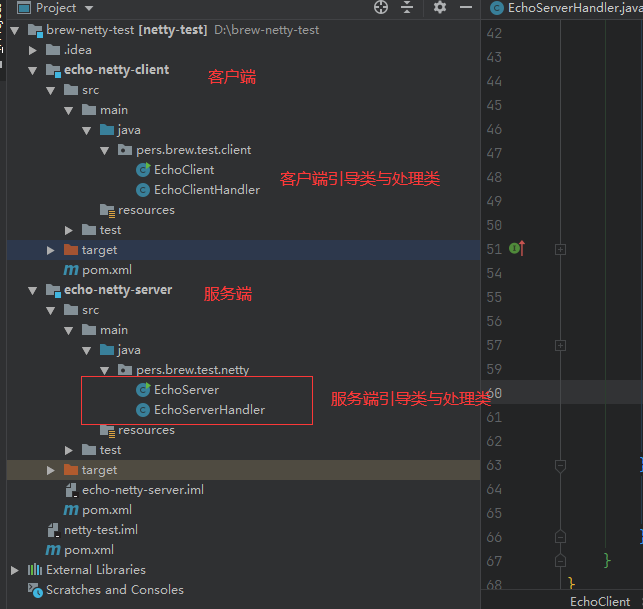netty相关实践
1.Netty的核心组件
- Channel;
- 回调;
- Future;
- 事件和ChannelHandler;
1.1 Channel
Channel是Java NIO的一个基本构造。
它代表一个到实体(如一个硬件设备、一个文件、一个网络套接字或者一个能够执行一个或者多个不同的I/O操作的程序组件)的开放连接,如读操作和写操作。
目前,可以把 Channel看作是传入(入站)或者传出(出站)数据的载体。因此,它可以被打开或者被关闭,连接或者断开连接。
1.2 回调
Netty 在内部使用了回调来处理事件;当一个回调被触发时,相关的事件可以被一个 interfaceChannelHandler 的实现处理。
当一个新的连接已经被建立时,
ChannelHandler 的 channelActive()回调方法将会被调用,并将打印出一条信息。
1
2
3
4
5
6
7
| public class EchoServerHandler extends ChannelInboundHandlerAdapter {
@Override
public void channelActive(ChannelHandlerContext ctx) throws Exception {
ctx.writeAndFlush(Unpooled.copiedBuffer("Netty server rock!", CharsetUtil.UTF_8));
}
}
|
1.3 Future
Future 提供了另一种在操作完成时通知应用程序的方式。这个对象可以看作是一个异步操作的结果的占位符;它将在未来的某个时刻完成,并提供对其结果的访问。
例如: 创建一个简单的channel载体 并且连接到远程节点,并且注册一个新的ChannelFutureListener。当监听器被通知已经建立连接的时候,会检查对应的状态,如果是操作成功的,那么可做对应处理。否则抛出异常
1
2
3
4
5
6
7
8
9
10
11
12
13
14
15
16
17
18
19
| Channel channel = ...;
ChannelFuture future = channel.connect(new InetSocketAddress("192.168.0.1", 25));
future.addListener(new ChannelFutureListener() {
@Override
public void operationComplete(ChannelFuture future) {
if (future.isSuccess()){
ByteBuf buffer = Unpooled.copiedBuffer("Hello",Charset.defaultCharset());
ChannelFuture wf = future.channel()
.writeAndFlush(buffer);
....
} else {
Throwable cause = future.cause();
cause.printStackTrace();
}
}
});
|
2.Netty简单示例(包含服务端与连接端)
项目结构:

2.1 编写Echo服务器
2.1.1 EchoServerHandler类
编写服务器处理类 我们只需要接收传入人的消息,并且做处理,此处原封返回传入端发送的信息。
- channelRead()—对于每个传入的消息都要调用;
- channelReadComplete()—通知ChannelInboundHandler最后一次对channelRead()的调用是当前批量读取中的最后一条消息;
- exceptionCaught()—在读取操作期间,有异常抛出时会调用。
1
2
3
4
5
6
7
8
9
10
11
12
13
14
15
16
17
18
19
20
21
22
23
24
25
26
27
28
29
30
31
32
33
34
35
36
37
38
39
40
41
42
43
44
45
46
47
48
49
50
| package pers.brew.test.netty;
import io.netty.buffer.ByteBuf;
import io.netty.buffer.Unpooled;
import io.netty.channel.ChannelFutureListener;
import io.netty.channel.ChannelHandler;
import io.netty.channel.ChannelHandlerContext;
import io.netty.channel.ChannelInboundHandlerAdapter;
import io.netty.util.CharsetUtil;
@ChannelHandler.Sharable
public class EchoServerHandler extends ChannelInboundHandlerAdapter {
@Override
public void channelActive(ChannelHandlerContext ctx) throws Exception {
ctx.writeAndFlush(Unpooled.copiedBuffer("Netty server rock!", CharsetUtil.UTF_8));
}
@Override
public void channelRead(ChannelHandlerContext ctx, Object msg){
ByteBuf in = (ByteBuf) msg;
System.out.println("Server received:"+in.toString(CharsetUtil.UTF_8));
ctx.write(in);
}
@Override
public void channelReadComplete(ChannelHandlerContext ctx){
ctx.writeAndFlush(Unpooled.EMPTY_BUFFER)
.addListener(ChannelFutureListener.CLOSE);
}
@Override
public void exceptionCaught(ChannelHandlerContext ctx, Throwable cause){
cause.printStackTrace();
ctx.close();
}
}
|
2.1.2 EchoServer引导服务器
在主要服务端启动口,我们需要指定开启的端口号,并且开启netty功能
1
2
3
4
5
6
7
8
9
10
11
12
13
14
15
16
17
18
19
20
21
22
23
24
25
26
27
28
29
30
31
32
33
34
35
36
37
38
39
40
41
42
43
44
45
46
47
48
49
50
51
52
53
54
55
56
57
58
59
60
61
62
63
64
65
| package pers.brew.test.netty;
import io.netty.bootstrap.ServerBootstrap;
import io.netty.channel.ChannelFuture;
import io.netty.channel.ChannelInitializer;
import io.netty.channel.EventLoopGroup;
import io.netty.channel.nio.NioEventLoopGroup;
import io.netty.channel.socket.SocketChannel;
import io.netty.channel.socket.nio.NioServerSocketChannel;
import java.net.InetSocketAddress;
public class EchoServer {
private final int port;
public EchoServer(int port) {
this.port = port;
}
public static void main(String[] args) throws InterruptedException {
if (args.length != 1) {
System.err.println(
"Usage: " + EchoServer.class.getSimpleName() +
" <port>");
}
int port = Integer.parseInt(args[0]);
new EchoServer(port).start();
}
private void start() throws InterruptedException {
final EchoServerHandler serverHandler = new EchoServerHandler();
EventLoopGroup group = new NioEventLoopGroup();
try {
ServerBootstrap b = new ServerBootstrap();
b.group(group)
.channel(NioServerSocketChannel.class)
.localAddress(new InetSocketAddress(port))
.childHandler(new ChannelInitializer<SocketChannel>() {
@Override
protected void initChannel(SocketChannel ch) throws Exception {
ch.pipeline().addLast(serverHandler);
}
});
ChannelFuture f = b.bind().sync();
f.channel().closeFuture().sync();
}finally {
group.shutdownGracefully().sync();
}
}
}
|
- EchoServerHandler 实现了业务逻辑;
- main()方法引导了服务器;引导过程中所需要的步骤如下:
- 创建一个 ServerBootstrap 的实例以引导和绑定服务器;
- 创建并分配一个 NioEventLoopGroup实例以进行事件的处理,如接受新连接以及读/写数据;
- 指定服务器绑定的本地的 InetSocketAddress;
- 使用一个 EchoServerHandler 的实例初始化每一个新的 Channel;
- 调用 ServerBootstrap.bind()方法以绑定服务器。
2.2 编写Echo客户端
Echo 客户端将会:
- 连接到服务器;
- 发送一个或者多个消息;
- 对于每个消息,等待并接收从服务器发回的相同的消息;
- 关闭连接。
2.2.1 EchoClientHandler类
- channelActive()——在到服务器的连接已经建立之后将被调用;
- channelRead0()——当从服务器接收到一条消息时被调用;
- exceptionCaught()——在处理过程中引发异常时被调用。
1
2
3
4
5
6
7
8
9
10
11
12
13
14
15
16
17
18
19
20
21
22
23
24
25
26
27
28
29
30
31
32
33
34
35
36
37
| package pers.brew.test.client;
import io.netty.buffer.ByteBuf;
import io.netty.buffer.Unpooled;
import io.netty.channel.ChannelHandler;
import io.netty.channel.ChannelHandlerContext;
import io.netty.channel.SimpleChannelInboundHandler;
import io.netty.util.CharsetUtil;
@ChannelHandler.Sharable
public class EchoClientHandler extends SimpleChannelInboundHandler<ByteBuf> {
@Override
public void channelActive(ChannelHandlerContext ctx) throws Exception {
ctx.writeAndFlush(Unpooled.copiedBuffer("Netty rock!", CharsetUtil.UTF_8));
}
@Override
public void channelRead0(ChannelHandlerContext channelHandlerContext, ByteBuf in) throws Exception {
System.out.println(
"Client received: " + in.toString(CharsetUtil.UTF_8));
}
@Override
public void exceptionCaught(ChannelHandlerContext ctx, Throwable cause) throws Exception {
cause.printStackTrace();
ctx.close();
}
}
|
2.2.2 EchoClient引导客户端
此处需要指定所连接的host 与端口port
1
2
3
4
5
6
7
8
9
10
11
12
13
14
15
16
17
18
19
20
21
22
23
24
25
26
27
28
29
30
31
32
33
34
35
36
37
38
39
40
41
42
43
44
45
46
47
48
49
50
51
52
53
54
55
56
57
58
59
60
61
62
63
64
65
66
67
68
69
| package pers.brew.test.client;
import io.netty.bootstrap.Bootstrap;
import io.netty.channel.ChannelFuture;
import io.netty.channel.ChannelInitializer;
import io.netty.channel.EventLoopGroup;
import io.netty.channel.nio.NioEventLoopGroup;
import io.netty.channel.socket.SocketChannel;
import io.netty.channel.socket.nio.NioSocketChannel;
import java.net.InetSocketAddress;
public class EchoClient {
private final String host;
private final int port;
public EchoClient(String host, int port) {
this.host = host;
this.port = port;
}
public static void main(String[] args) throws InterruptedException {
if(args.length != 2){
System.err.println(
"Usage: " + EchoClient.class.getSimpleName() +
" <host> <port>");
return;
}
String host = args[0];
int port = Integer.parseInt(args[1]);
new EchoClient(host, port).start();
}
private void start() throws InterruptedException {
EventLoopGroup group = new NioEventLoopGroup();
try{
Bootstrap b = new Bootstrap();
b.group(group)
.channel(NioSocketChannel.class)
.remoteAddress(new InetSocketAddress(host,port))
.handler(new ChannelInitializer<SocketChannel>() {
@Override
protected void initChannel(SocketChannel ch) throws Exception {
ch.pipeline().addLast(
new EchoClientHandler()
);
}
});
ChannelFuture f = b.connect().sync();
f.channel().closeFuture().sync();
}finally {
group.shutdownGracefully();
}
}
}
|
2.3 启动客户端与服务器
Server端接收到:

Client端接收到:




